
Economic Affairs, Vol. 65, No. 4, pp. 491-497, December 2020
DOI: 10.46852/0424-2513.4.2020.3

Research Paper
An Economic Analysis of Production of Isabgol and Constraints Faced by Farmers in Rajasthan
ABSTRACT
The study was carried out in Barmer district of Rajasthan to analyze economics of Isabgol production and constraints faced by farmers. The primary data were collected from total sample of 80 farmer's respondents. The study reveals that total cost of cultivation was higher ₹ 38407.69 per hectare on large farm, followed by ₹ 34132.15 on medium and ₹ 31281.96 on small farm and ₹ 34607.27 per hectare on overall farm. The cost of cultivation increases as farm size increase. It is observed from the result of F test p value is .001 which shows that there is statistically significant difference in cost of cultivation of Isabgol on different farm size category. The different cost on the basis of cost concept (Cost A1, A2, B1, B2, C1, C2 and C3) of Isabgol cultivation per hectare was calculated. The cost of production was found lower on large farm it was found to be ₹ 5053.64 per quintal followed by ₹ 5094.35 per quintal on medium farm, ₹ 5128.19 per quintal for small size farm which was found highest and ₹ 5092.06 per quintal for overall farm size. Farm business income, family labor income and farm investment income of Isabgol cultivation was found highest on large farm. The benefit cost ratio was found at 1.63 for overall farm size and was found to be 1.68 for large farm, 1.64 for medium farm and 1.63 for small farm. Crop damage by pest and diseases are the most important constraints faced by farmers in Isabgol production.
Highlights
 The total cost of cultivation was found higher on large farm and is increases as farm size increase.
The total cost of cultivation was found higher on large farm and is increases as farm size increase.
 The cost of production was lower on large farm and highest on small farm.
The cost of production was lower on large farm and highest on small farm.
 Gross return and Net returns was higher on large farm compare to medium and small farm. Input-output ratio was higher on large farm.
Gross return and Net returns was higher on large farm compare to medium and small farm. Input-output ratio was higher on large farm.
Keywords: Isabgol, cost of cultivation, farm business income, benefit cost ratio
Isabgol is an important Medicinal crop of India. Isabgol is also known as Ispaghula or psyllium, psyllium seeds husks are portion of the seeds of the plant Isabgol. Isabgol (Plantago ovata Forsk) belongs to family Plantaginaceae. Isabgol is mainly grown for its seeds. India is top producer of these seeds and husk. Isabgol is short stem medicinal annual herb and commercially an important Rab season medicinal crop grown in India. The seed coat is also known as husk which has medicinal value. It is also being used in food industry especially in icecream, biscuits and candies. The mucilage content in Isabgol seed cultivated in India is higher. Colloidal mucilage is valuable for medicinal application (Pagaria & Kantwa, 2014). This crop is commercially cultivated mainly in the states of Rajasthan, Gujarat and Madhya Pradesh. India is the world's largest producer and exporter of Isabgol in the world. In India, Rajasthan has largest area under Isabgol cultivation. Area and production of Isabgol in India is presented in Table 1.
How to cite this article: Rathore, R. and Mathur, A. (2020). An Economic Analysis of Production of Isabgol and Constraints Faced by Farmers in Rajasthan. Economic Affairs, 65(4): 491–497.
Source of Support: None; Conflict of Interest: None 

In India, Isabgol is predominately cultivated in Rajasthan and Gujarat states. In Rajasthan, the major area under Isabgol cultivation is in Barmer, Jalore, Nagaur, Jodhpur, Jaisalmer, and Chittor districts. Presently its cultivation is becoming more popular in western part of Rajasthan because of poor soil fertility and low water availability in the area (Sharma & Ratnoo, 2013). The important high yielding varieties of Isabgol cultivation in India are Gujarat Isabgol 3 (GI3), Gujarat Isabgol 2 Gujarat Isabgol1 (GI2, GI1), Jawaharlal Isabgol 4, Haryana Isabgol 5, Niharika etc. The medicinal plant market in India is rapidly increasing over the years due to increasing consumer demand for herbal and natural products. A part from these medicinal uses, it has a place in dyeing, calico printing, in the ice-cream in as a stabilizer also in confectionery and cosmetic industries (Meena, et al. 2015)
Objectives Data Sources and Methodology
The objectives of the study was to estimate cost and return of Isabgol cultivation and to identify the constraints faced by farmers in production of this important medicinal crop. Primary data were collected by personal interaction and interviewed method during the year 2019. The secondary data were collected from government agriculture department of Rajasthan and various published sources. Rajasthan occupied highest area under cultivation of the Isabgol crops. The Barmer district has highest area under Isabgol cultivation. Barmer district were selected purposively for the study. Two tehsils from each district Dhorimana and Sedwa for Isabgol were selected having highest area under cultivation of the crop. A list of Isabgol cultivation villages and farmers prepared. Four village from each tehsils were also selected to make the total sample size of 80 growers/farmers. The farmers’ were categorized in to 3 groups small, medium and large, below 2 hectare (small) 2–10 hectare (medium) and more than 10 hectare (large).
Analytical Tools
The cost of cultivation of Isabgol was work out by using various cost concepts.
Cost A1 include all real expenditures in production by the farmer.
Cost A2 = Cost A2 include, cost A1+ rental value of leased in land
Cost B1 = Cost B1 include, cost A1+ interest on fixed capital +rental value of land
Cost B2 = Cost B2 include, cost B1 + rent paid for leased in land + rental value of owned land
Cost C1 = Cost C1 include, cost B1 + value of family labor
Cost C2 = Cost C2 include, cost B2 + value of family labor
Cost C3 = Cost C3 include, cost C2 + 10 per cent of cost C2 as managerial cost
Net income measure: It is surplus after subtracting all the cost
Net return = Gross return - Total cost
The Benefit Cost Ratio (BCR) measures the returns or benefits per unit cost of investment.
B: C ratio was worked out by using following the formula
BC Ratio = Total Cash inflows/ Total Cash outflow
Cost of Production = Cost of cultivation per ha/ Production per hactare
Income Measures
For the calculation of profitability of Isabgol cultivation in the study area following income measures were workout:
(a) Farm Business income = Gross income -Cost A1/A2
(b) Family labor income = Gross income -Cost B2
(c) Farm investment income = Farm business income- value of family labor OR net income + rental value of land+ interest on fixed capital
Operational cost ratio = Variable cost/Gross income
Fixed cost ratio = Fixed cost/Gross income
Gross cost ratio = Gross cost/Gross income
Input-output ratio = Gross income/Gross cost
Henry Garrett Technique was used to analyze the constraint faced by the farmers. The respondents were asked to rank the constraints and these were converted in to scores.
Percent position = 100*(Rij - 0.5)/ Nj
Where,
Rij = Rank given for ith factor by jth individual
Nj = Number of factors ranked by jth individual
RESULTS AND DISCUSSION
Economics of Isabgol Production
It is clear from the table 2 total cost of cultivation was found highest at ₹ 38407.69 on large farm, followed by ₹ 34132.15 on medium and ₹ 31281.96 on small farm and ₹ 34607.27 on overall farm. It is clear from the table 2 the cost of cultivation increases as farm size increases. The rental value of land share was highest percentage to total cost (12.88) on small, (11.88) on medium, (10.55) on large and (11.69) on overall farm in overhead cost. The machinery charge accounted highest in operational cost item to total cost. The cost of depreciation accounted to 7.25 per cent to total cost on small, 7.47 per cent on medium and 7.37 per cent on large to total cost items in the study area.
The test of significance, F test was applied using SPSS for testing the significance difference in cost of Isabgol on small, medium and large farm. The Table 3 shows the result of F test.
It can be observed from the result of F test p value is .001 which shows that there is statistically significant difference in cost of cultivation of Isabgol on small, medium and large farm. The item wise break-up of cost of cultivation in per cent to total cost on overall farmers depicted in the Fig. 1.
Cost of cultivation of Isabgol on the basis of different cost concepts
The different cost groups was calculated with the help of different cost concepts. Use of these cost concepts helps in calculation of the different cost and these cost helps in measuring the different farm incomes like farm business income, family labor income and farm investment income. The different cost (Cost A1, A2, B1, B2, C1, C2 and C3) of Isabgol cultivation per hectare was calculated.
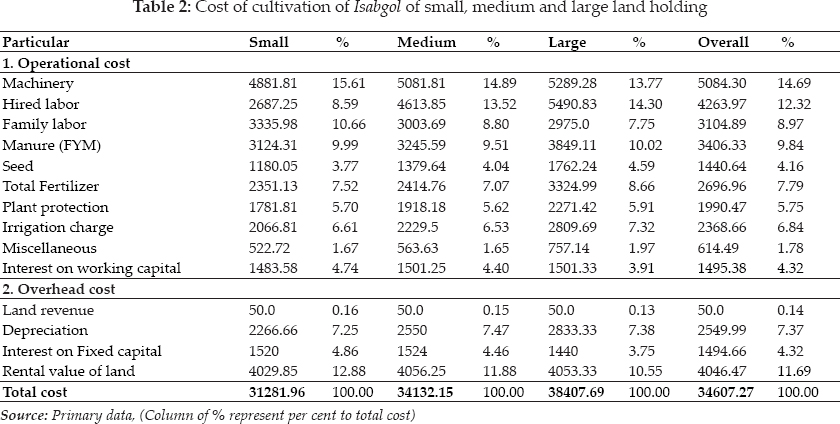


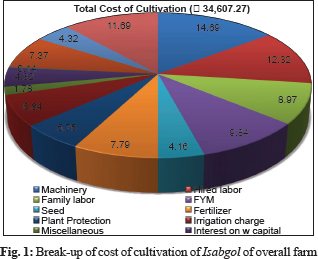
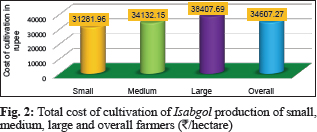
Cost A1 and A2 was found similar, total cost increases as the farm size increase, it was found at ₹ 22,396.13 per hectare on small, ₹ 25,548.29 per ha on medium ₹ 25,960.87 per hectare and ₹ 25,960.87 per hectare on overall farm size. Cost B1 was found to be ₹ 23,916.13 per hectare on small, ₹ 27,072.29 per hectare on medium farm, ₹ 31,379.36 per hectare on large farm size ₹ 27,455.53 per hectare on overall farm. Cost B2 was found at ₹ 31,502.0 per hectare on overall farm, cost C2 was found ₹ 34,606.89 per hectare on overall farm. The cost C3 was found to be ₹ 34,410.56 on small, ₹ 37,545.45 on medium ₹ 42,248.45 on large and ₹ 38,067.49 per hectare on overall farm. The different cost groups are presented in the table 5 and in table 4.
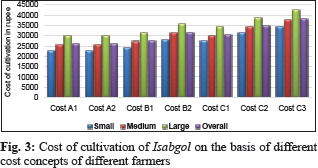
Farm business income, family labor income and farm investment income
The data collected revealed that farm business income, family labor income and farm investment income increases with increase in farm size. The farm business income was found to be ₹ 29454.17 per hectare for small, ₹ 30551.91 per hectare for medium, ₹ 34660.64 per hectare for large and ₹ 31555.57 per hectare for overall farm size. The family labor income was found lower than farm business income for small, medium, large and overall farm size. It was found ₹ 23,904.34, ₹ 24,971.66, ₹ 29167.31, ₹ 26,014.43 per hectare for small, medium, large and overall farm size respectively. Farm investment income was found highest at ₹ 31685.64 per hectare for large size farm, followed by ₹ 27548.22, per hectare for medium, ₹ 26118.19 per ha for small and ₹ 28450.68 per hectare for overall farm. The cost of production was found lower on large farm it was found to be ₹ 5053.64 per quintal followed by ₹ 5094.35 per quintal on medium farm, ₹ 5128.19 per quintal for small size farm which was found highest and ₹ 5092.06 per quintal for overall farm size. The benefit cost ratio was found at 1.63 for overall farm size and was found to be 1.68 for large size farm, 1.64 for medium farm and 1.63 for small farm size.
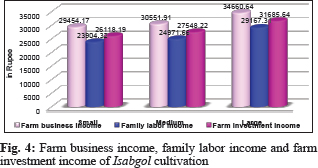
Cost of production, operational cost and overhead cost of Isabgol cultivation
The gross return and net return was found highest at ₹ 64600 and ₹ 26192.31 on large farm followed by ₹ 56100.2 and ₹ 21967.85 on medium and ₹ 51850.3 and ₹ 20568.04 on small farm respectively. The gross return and net return was found to be ₹ 57516.83 and ₹ 22909.40 on overall farm.
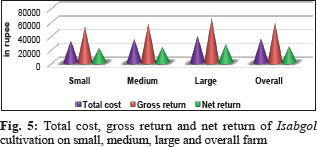
Cost of production of Isabgol on small, medium, large and overall farms was found to be at ₹ 5213.66, ₹ 5251.10, ₹ 5121.02 and ₹ 5195.26 per quintal respectively. The operational cost was found highest at ₹ 30,028.03 per hectare on large farm followed by ₹ 25,951.45 per hectare on medium farm, ₹ 23,415.45 on small farm and it was ₹ 26,465.12 on overall farm. The fixed cost also accounted highest on ₹ 8,379.66 per hectare followed by ₹ 8,180.35 on medium, ₹ 7,866.51 on small and ₹ 8,142.17 on overall farms respectively.
It is clear from the table 6 that cost of production was highest on small farm ₹ 5128.19 followed by ₹ 5094.35 on medium and ₹ 5053.64 per quintal on large farm. The cost of production decreases as farm size increases, on overall farm cost of production was found to be ₹ 5092.06 per quintal. Total operational cost and fixed cost was found to be at ₹ 26465.12 and ₹ 8142.17 per hectare respectively on overall farm.
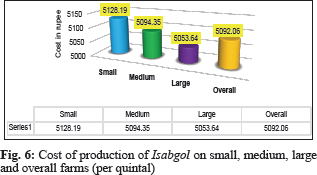
Cost-Benefit Ratio of Isabgol cultivation
The data collected from the respondents regarding the cost and the benefit associated was used to calculate the operational cost ratio. It was observed that the operational cost increases as farm size increases and was found highest to be 47.10 per cent for large farm size followed by 46.25 per cent for medium, 45.15 per cent for small size and 46.16 per cent was found for overall farm size. Fixed cost ratio was found to be 14.23 per cent for overall farm size. The input-output ratio was found highest at 165.19 per cent for large size farm, followed by 165.75 per cent for small farm size, lowest 164.36 per cent for medium size farm and 166.19 per cent was found for overall farm size. Gross cost ratio was found to be highest at 60.84 per cent on medium farm, followed by 60.33 per cent for small and lowest at 59.45 per cent for large farm size and 60.20 per cent for overall farm size.




Constraints faced in Isabgol production of sample farmers in the study area
Farmers in the study area were inquired about the different constraints faced in Isabgol production and their responses were analyzed using Garett ranking (Henry Garret). The highest Garett score 68 was found for the problem related to crop damage by pest and diseases during fluctuation in weather condition and it was observed to rank first among all the problems. Lack of credit availability and requirement during crop grown period received the Garett score of 66 which was rank second among all the problems. Garett score problem related to lack of technical knowledge was found to be 47 at rank third followed by lack of good seed availability at rank fourth. The table 8 presents in detail.
CONCLUSION
Cost and returns of Isabgol cultivation was found higher on large, medium and small farmers. The cost of cultivation of Isabgol was found highest ₹ 38407.96 on large farm, followed by ₹ 34132.15 on medium size farm, ₹ 31281.96 on small farm and 34607.27 on overall farm size. The cost of cultivation increases as farm size increases. There is significant difference were found in cost of Isabgol cultivation on small, medium and large farm. The cost of production of Isabgol was found higher ₹ 5128.19 on small farm followed by ₹ 5094.35 medium and ₹ 5053.64 per quintal on large size farm. Benefit Cost (BC) Ratio was found higher on large farm followed by medium and small farm. The benefit cost ratio was found 1.65 on overall farm size it indicate cultivation of Isabgol crop is beneficial for the farmers. Farm business income, family labor income, farm investment income, Gross return and Net return income was found highest on large farm followed by medium size farm and small size farm. On overall farm size farm business income was ₹ 31555.57, family labor income was ₹ 26014.43, and farm investment income was ₹ 28450.68 Gross return was ₹ 57516.83 and Net return income was ₹ 22909.40. The most important constraints identified of the production of Isabgol was damage by pest and diseases of crop followed by lack of credit availability.
Policy Implication
The government should provide training and extension activities to train the farmers for the management of the pest and diseases of Isabgol crop during unfavorable climate to reduce losses of crop and to increase the production of crop for better return for the farmers. The economics of crop was found beneficial for the farmers in term of returns. So farmers should encourage towards opportunities of agribusiness for this crop. Government should emphasized on releasing high yielding and diseases resistant variety. Credit facilities should be avail to the needy farmers to cultivate this crop on large size farm of the farmers.
ACKNOWLEDGEMENTS
This paper and the research behind it would not have been possible without guidance of my guide and advisory members. I am thankful to Dr. Kaushal Kumar Subject Matter Specialist, Department of Forest Products & Utilization, Faculty of Forestry, Birsa Agricultural University Kanke, Ranchi. Dr. Madhu Sharma, Director of Institute of Agri Business Management for their guidance during the study.
REFERENCES
Anonymous. 2007. Farm Cost Studies of Important Crops, Second Agricultural Economics, Agricultural Statistics and Extension Education Sub-committee Report, J.A.U., Junagadh, pp. 10.
Ahirwar, R.F, Kumar, V.A. and Shekhawat, L.S. 2014. Cost and income structure of wheat cultivation in Vindhyan Plateau of Madhya Pradesh. Economic Affairs, 60(1): 83–88.
Guleria, C., Kumar Vaidya, M., Sharma, R. and Dogra, D. 2014 Economics of Production and Marketing of important Medicinal and Aromatic Plants in Mid Hills of Himachal Pradesh. Economic Affairs, 59(3): 363–378.
Jadhav, M.S., Pagri, B.V. and Vaidkar, R.D. 2001. Production and Marketing of Isabgol and Patchouli in Maharashtra. National Research Seminar on Herbal Conservation, Cultivation, Marketing and Utilization, pp. 93.
Jat, R.S., Nagaraja R., Reddy, R.B. and Manivel P. 2015 Good agricultural practice for Isabgol, extension bulletin, Directorate of Medicinal and Aromatic Plants Research Boriavi, Anand, pp. 9.
Khan, N. and Sharma, O.H. 2010. Cultivation of medicinal and aromatic crops as a means of diversification in agriculture in Madhya Pradesh. Project report pp.1-116, http://jnkvv.org/PDF/AERC/Study-93.pdf
Madhavji, T.P. 2009. Economic analysis on production and marketing of major medicinal crops of Gujarat state Ph.D. (Ag.) Thesis, JAU, Junagarh, (Gujarat)
Meena, S., Singh, I.P. and Meena, R. 2016. Cost of cultivation and returns on different cost concepts basis of Onion in Rajasthan. Economic Affairs, 61(1): 11–61.
Meena, V., Dotania, B., Meena, B. and Das, H. 2015. Isabgol A medicinal herbs, good source of income generation in water scarcity region. Popular Kheti, 3(4): 1–5
Pagaria, P. and Kantwa, S.L. 2014. Economics and gap analysis in Isabgol cultivation through frontline demonstrations in Barmer district, Agriculture Update, 4(9): 596–598.
Sharma, N.K. and Ratnoo, S.D. 2013 Yield optimization in Isabgol through seed and fertilizer management practices in Transitional Plain of Luni Basin of Rajasthan. Indian Journal of Arid Horticulture, 8(1-2): 65–67.